

Damion Smy
GWM Cannon Alpha ute, Tank 300 HEV and Tank 500 recalled
13 Hours Ago
The new Lexus RX 350 rides a new platform and swaps its old V6 in favour of a turbo four – but is it any sportier?
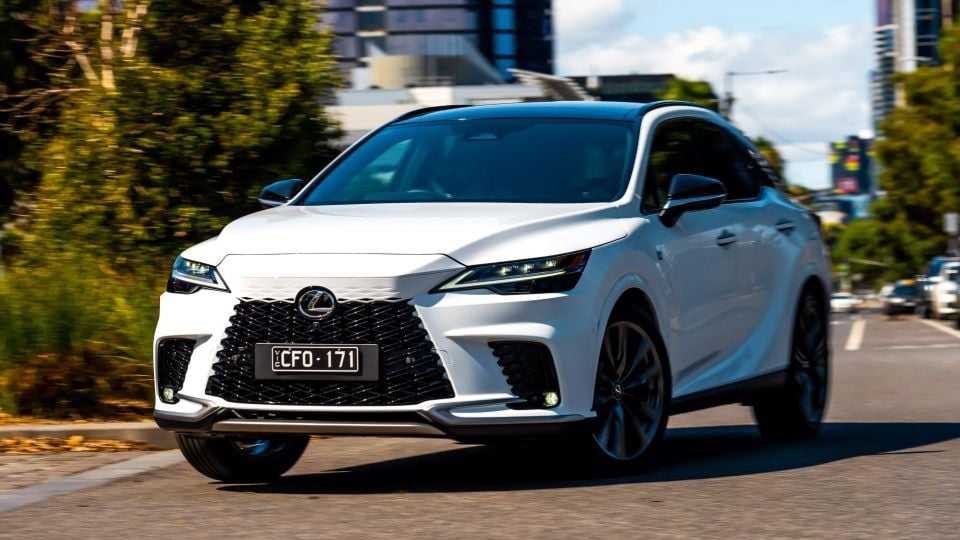
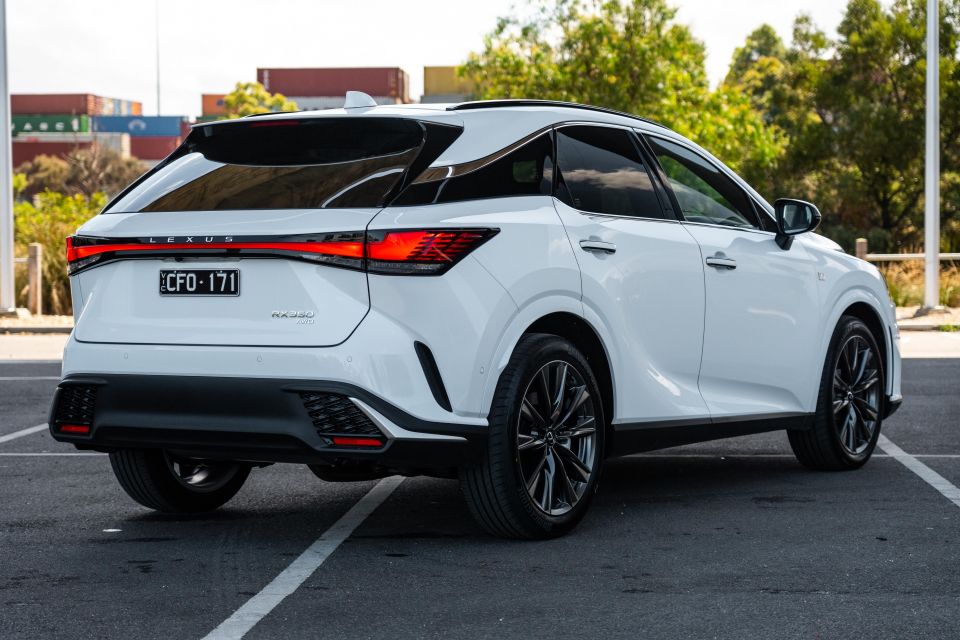

Quickly see how this car stacks up against its competition. Select any benchmark to see more details.
Where expert car reviews meet expert car buying – CarExpert gives you trusted advice, personalised service and real savings on your next new car.
Lexus has produced plenty of genuinely sporty vehicles over the years, from the LFA to the GS F, but the RX has never been one of them.

With the new fifth-generation model that arrived here earlier this year, however, Lexus seems more serious than ever about positioning it – or at least some of its variants – as a sporty SUV.
There’s a new hero model, the RX 500h F Sport Performance, that sits at the pinnacle of the range and offers both turbocharging and a hybrid system. Below that sits the hybrid RX 350h and the turbocharged RX 350.
Unlike the last RX, the F Sport isn’t available with a regular hybrid powertrain or with front-wheel drive. Instead, it comes only in the all-wheel drive RX 350, which swaps the old petrol V6 for a turbocharged four.
There are the usual F Sport accoutrements like sports seats and unique trim; think of F Sport as Lexus’ equivalent to BMW’s M Sport, offering a sportier look and feel without going to the extreme of being a full-fat M (or in this case, F) model. It also continues to distinguish itself with standard adaptive suspension, as well as aluminium monobloc six-piston brake calipers.
On the surface it seems to be a more serious stab at a sporty SUV and not just a trim package.
It helps with appearances, too, that the new RX is a much sleeker looking vehicle than before. It looks lower and more hunkered-down, even if it’s an almost identical height to the old car. There’s still the fussy detailing we’ve come to expect from Lexus models from the past decade or so, but it nevertheless looks sportier.
The question is: is this actually a sporty SUV?
The Lexus RX has always occupied a somewhat different space than its rivals from BMW and Mercedes-Benz, using a front/all-wheel drive Toyota platform and offering dimensions closer to the X5 and GLE but with pricing more in line with the X3 and GLC.
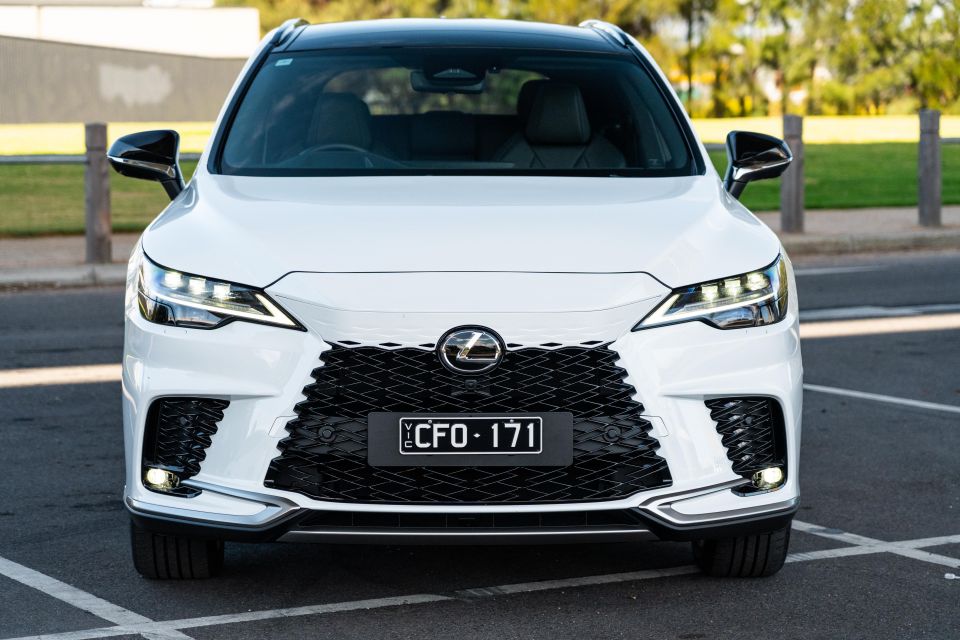
The range opens at $86,904 before on-road costs for the RX 350h Luxury FWD, and tops out at $124,675 before on-roads for the RX 500h F Sport Performance AWD.
Our featured vehicle is somewhere near the middle: an RX 350 F Sport AWD, which is priced from $98,370 before on-roads, equipped with the $4100 Enhancement Pack 2.
It’s also finished in White Nova paint. All exterior finishes bar Graphite Black cost an additional $1840. Based on a Sydney postcode, you’re looking at a drive-away price of $113,275.
The RX’s pricing puts it up against the externally smaller BMW X3 xDrive30i M Sport ($96,500) and Mercedes-Benz GLC 300 ($104,900), and it significantly undercuts petrol-powered X5 and GLE models.
This pricing also wedges it between mid-sized and large SUVs from other luxury brands. For example, the priciest petrol-powered Audi Q5 wagon – the 45 TFSI quattro Sport – is $82,800, while the cheapest Q7 is $108,469.
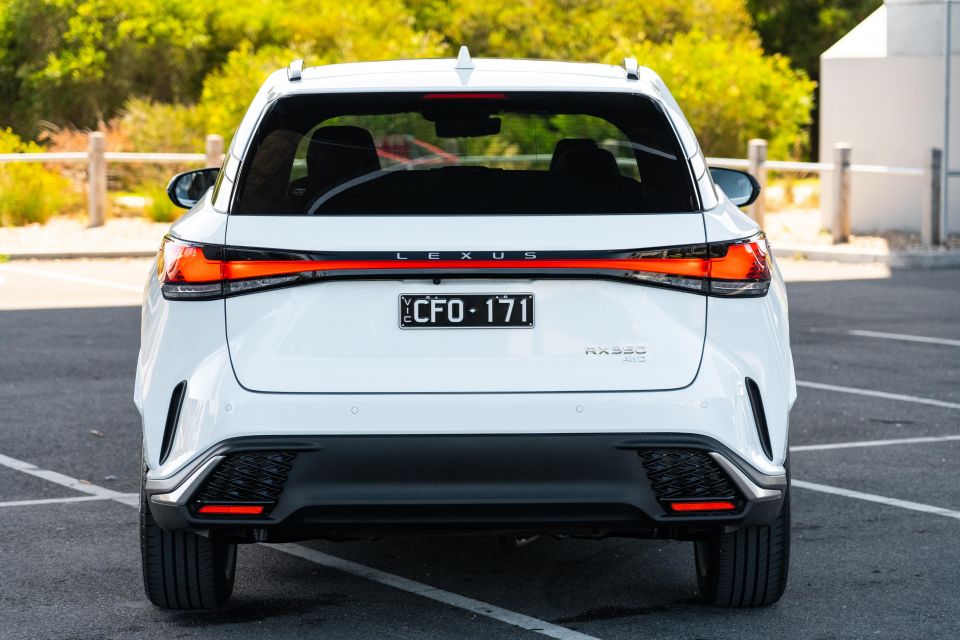
It’s also pricier than a range-topping Genesis GV70 3.5T AWD Sport ($85,100) but cheaper than the most affordable GV80 ($105,700).
The RX 350 F Sport undercuts the Range Rover Velar, which opens at $106,250 before on-roads, but its price puts it above the Volvo XC60 Ultimate B6 Dark ($86,990).
Then there are the cars from brands without a premium badge. Volkswagen’s diesel-only Touareg range is priced from $89,240. Mazda’s CX-60 can be had with a petrol engine in top Azami spec for $74,154, and likewise its larger three-row CX-90 in the same spec costs $95,185 – all prices above exclude on-road costs.
Buy your new car without the stress. It's fast, simple and completely free.

Great service from Travis and team, second time I have used this business would not hesitate to recommend them to anyone
Craig C.
Purchased a Ford Ranger in Sunshine Coast, QLD
CarExpert helped Craig save thousands on his Ford Ranger, now let us save you on your next new car.
Find a dealThe Lexus RX’s interior is a class act, and finally the brand is offering in-car technology that passes muster in the luxury car market.
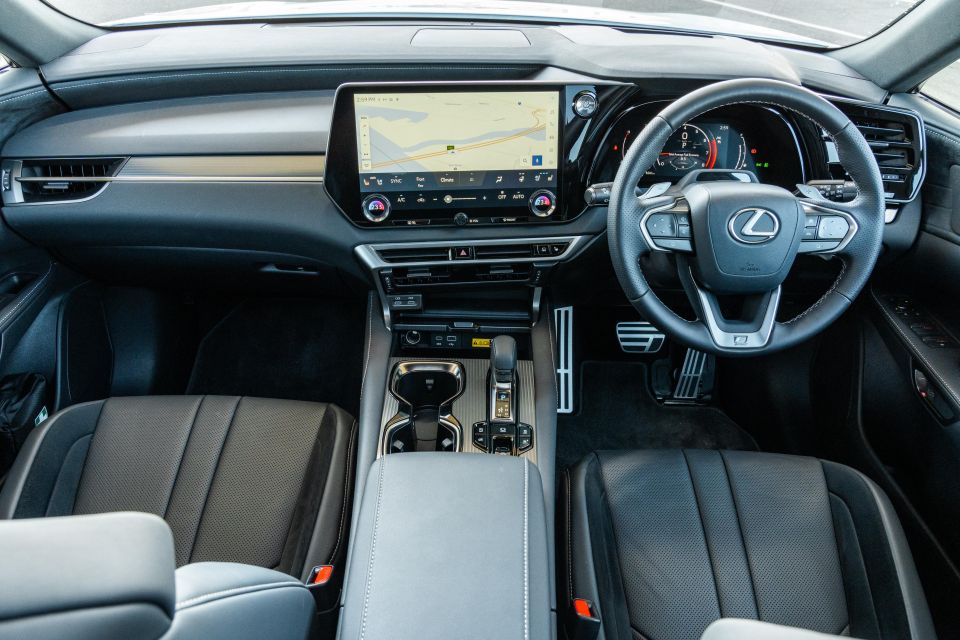
Mind you, Lexus’ new infotainment system is shared with lesser Toyotas, and there’s no unique skin for it like you’ll find in say, a Genesis versus a Hyundai.
Nevertheless, we’re happy to see crisp, clear graphics; an actual touchscreen instead of a trackpad-based interface; wireless Apple CarPlay (but wired Android Auto); and an easily accessible shortcut bar. The latter is always present on the screen, and allows you to jump to functions like smartphone mirroring and satellite navigation.
An icon resembling six squares also takes you to commonly used features such as drive mode selection. And you don’t need to dive into menus for things like climate control and the heated/ventilated seat controls as these will also always appear on the screen.
The camera quality is also much improved over past Lexus models, if not quite reaching segment-best status. The surround-view camera includes a see-through mode, which is handy.

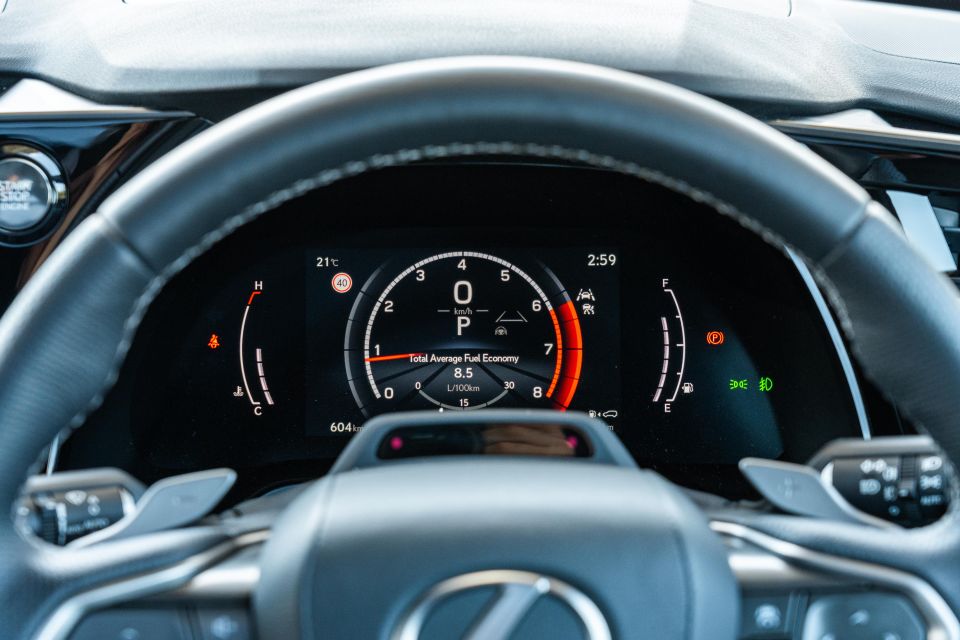
One thing we do miss from Lexuses of old is the twist-knob drive mode selector. It may not have been widely loved, but it was easier to use than the new touchscreen-based drive mode selection.
At least Lexus is still pro-knob (and pro-button) when it comes to climate control, and there’s plenty of physical switchgear for other key functions.
Material quality is superb, as you would expect from a Lexus. Yes, the lowest reaches of the doors are hard plastic, but otherwise there are swathes of plush materials including suede inserts for the doors and a dash top and centre console that use some of the softest surface materials I’ve experienced in a new car.
The paddle shifters also feel like real metal, and not chintzy plastic units.


There’s an elegant look to the cabin. The large touchscreen doesn’t look entirely like a tablet jutting out of the dash, there’s attractive contrast trim and stitching elements to break up all the black, and gloss black trim is kept to a relative minimum.
There’s colour-adjustable ambient lighting, but it’s muted; while I quite like the piece of stitched, suede trim that wraps around one half of the dash, giving it a two-tier appearance.
Everything is screwed together with the level of care you’d expect from a Lexus, and we observed no build quality issues like rattles and creaks. The doors have a solid feel, and you quickly get used to Lexus’ new-style handles. The handles are also helpfully illuminated.
There are other thoughtful touches, too, like lock settings that allow you to open any door to unlock the car, and seats that remember the level of heating and ventilation you had selected before restarting the vehicle.
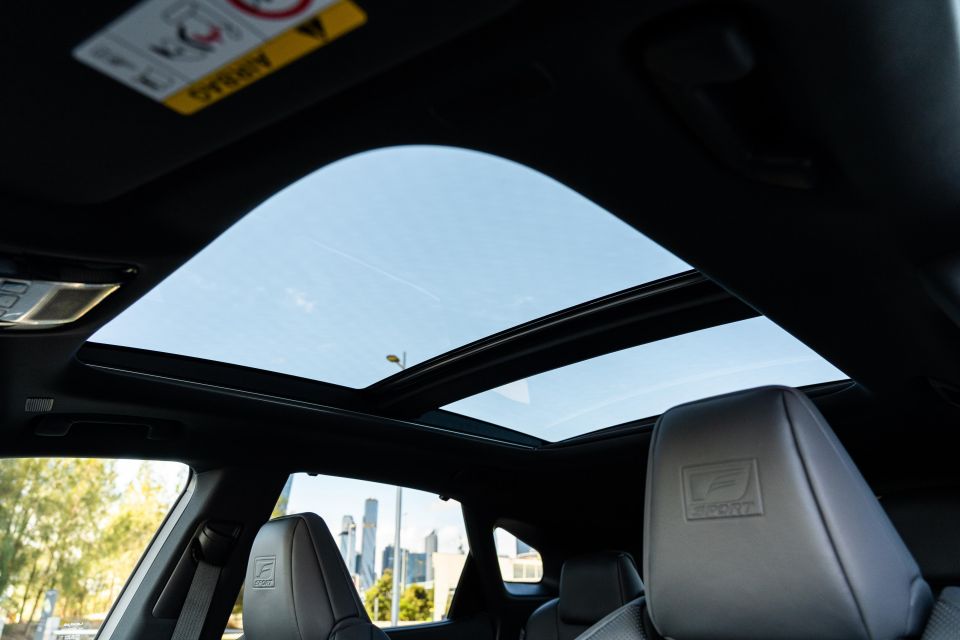
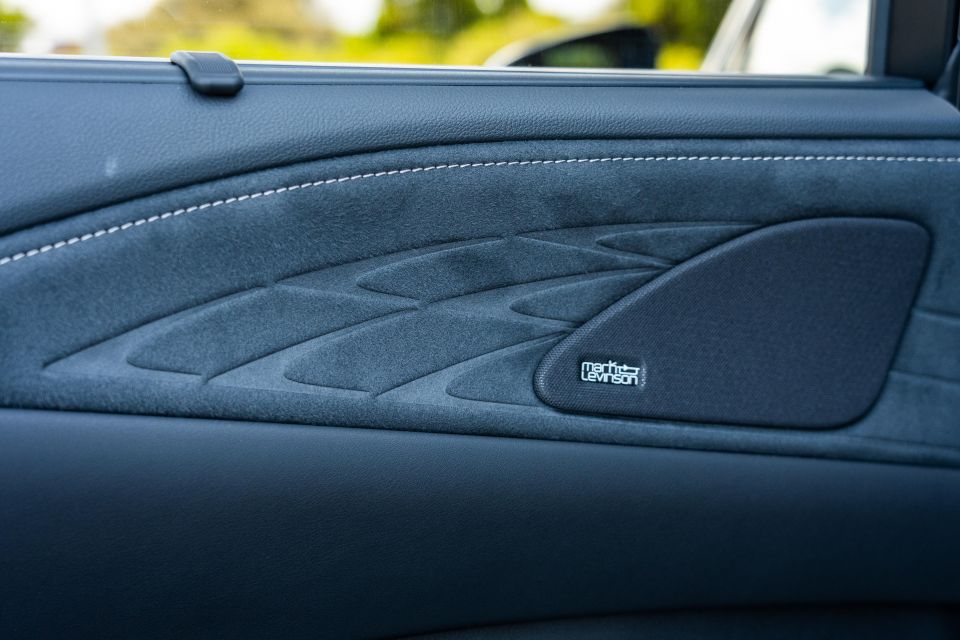
Those ventilated seats also work superbly, and indeed the seats are particularly comfortable and supportive with a decent amount of bolstering. It’s a comfortable car to spend a hot day in, too, with excellent air-conditioning and a well-calibrated Lexus Climate Concierge function – a fancy term for ‘auto’ mode, really.
The steering wheel is lovely to grip with its perforated leather, though the touch-capacitive controls take some getting used to. The four buttons on each side correspond with a menu that appears in the head-up display, but this system means some functions require an extra press or two.
The digital instrument cluster follows the same central circle theme as past Lexus models like the LFA, and therefore has a sporty yet legible look. Pop the RX in Sport mode and you also get a slick, Mustang-like bar tachometer at the top.
Storage up front is decent, with a spacious centre console bin that can be opened from either side and features a delectably soft lid.
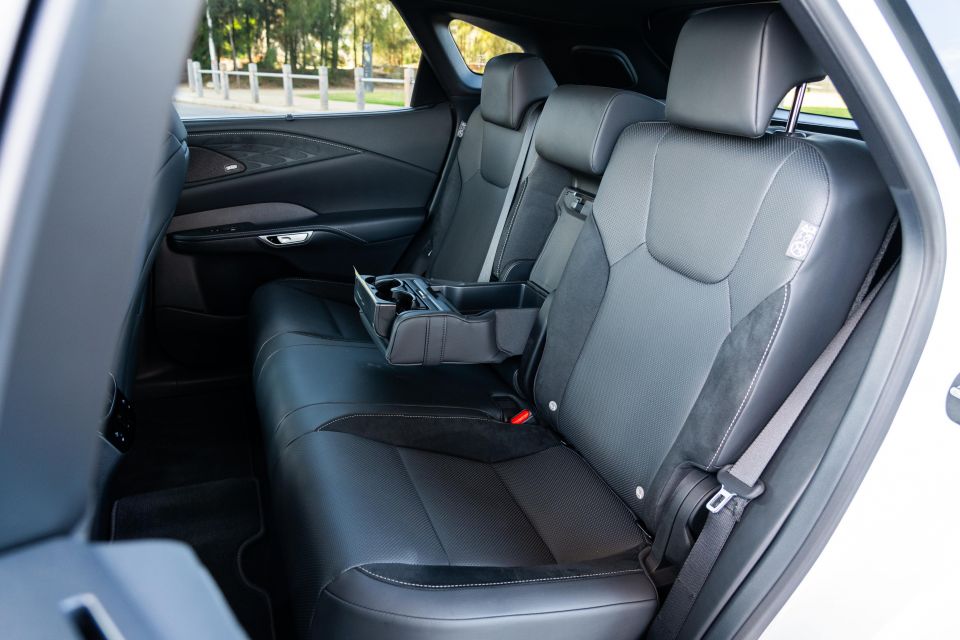

There are USB-C outlets in the cabin, though Lexus still uses a USB-A outlet for smartphone mirroring.
Step into the back and you’ll find two more USB-C outlets, plus temperature controls, a fold-down centre armrest, and bottle holders that fit 1L bottles like those up front.
The subtle ambient lighting also carries through, while the rear bench is very comfortable.
The floor is mostly flat, aiding legroom for the centre-seat occupant. Those measuring 180cm or taller will find their heads touching the roof, while the roof also fares in slightly at the sides and impacts headroom for the outboard occupants.

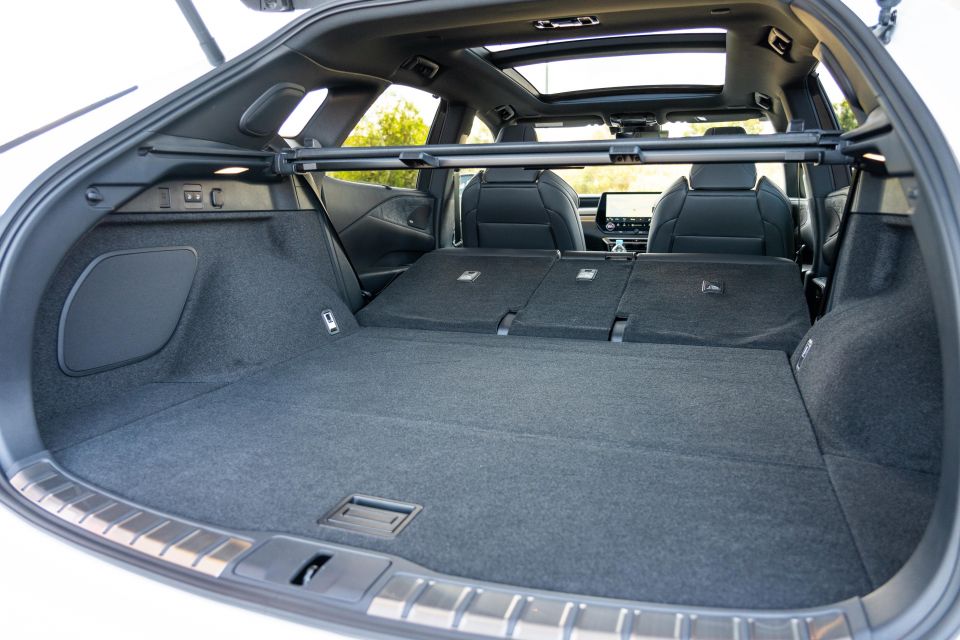
There are three top-tether and two ISOFIX anchor points for child seats.
Open the tailgate and you’ll find 612L of space, as well as a 120V outlet. There are also buttons to drop the second row, which expands total storage capacity to 1678L. Under the boot floor sits a space-saver spare.
The RX 350 is powered by a 2.4-litre turbocharged four-cylinder petrol engine with 205kW of power and 430Nm of torque.
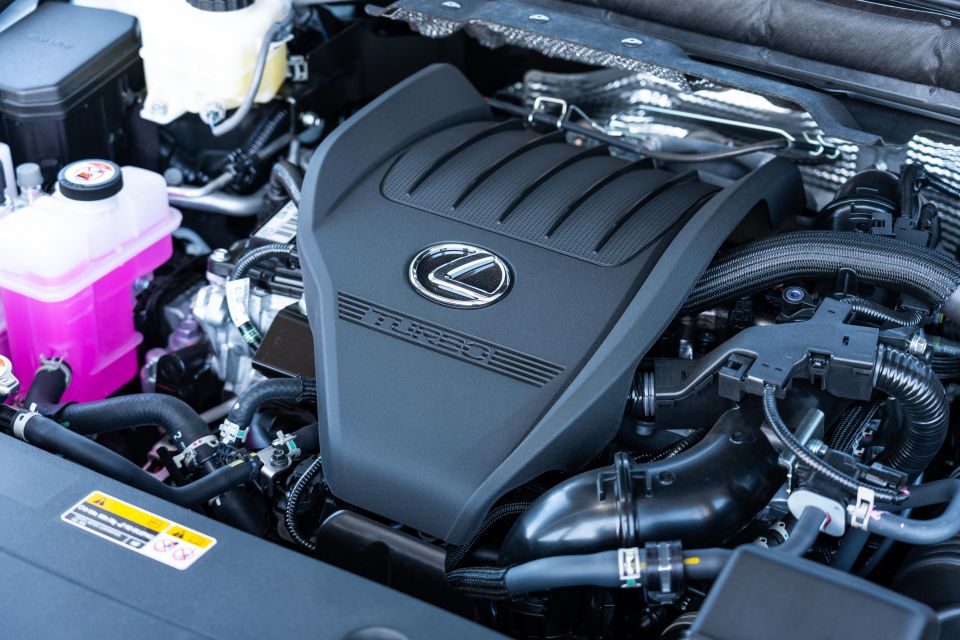
It’s all-wheel drive only and uses an eight-speed automatic transmission.
The new, smaller engine sees power down by 16kW on the old 3.5-litre V6, though torque is up by 60Nm. Fuel economy has also improved from 9.6L/100km on the combined cycle to 8.7L/100km.
Over a loop comprising inner-city, suburban and highway driving, however, we still recorded a claim of 9.6L/100km. On a highway run we saw 7.6L/100km, while overall after a week of driving the RX 350 was sitting at 10L/100km.
If maximum fuel efficiency is your desire, then, best to look at the RX 350h. In all-wheel drive guise, the hybrid powertrain boasts claimed fuel economy of 5.4L/100km, while its 0-100km/h time is only 0.3 seconds slower.
All RX models require 95 RON premium unleaded fuel. The RX 350 has a 67.5L fuel tank.
We don’t think anybody really expects a Lexus RX to be the athlete of the class, but this isn’t simply a soft, floaty cruiser either.
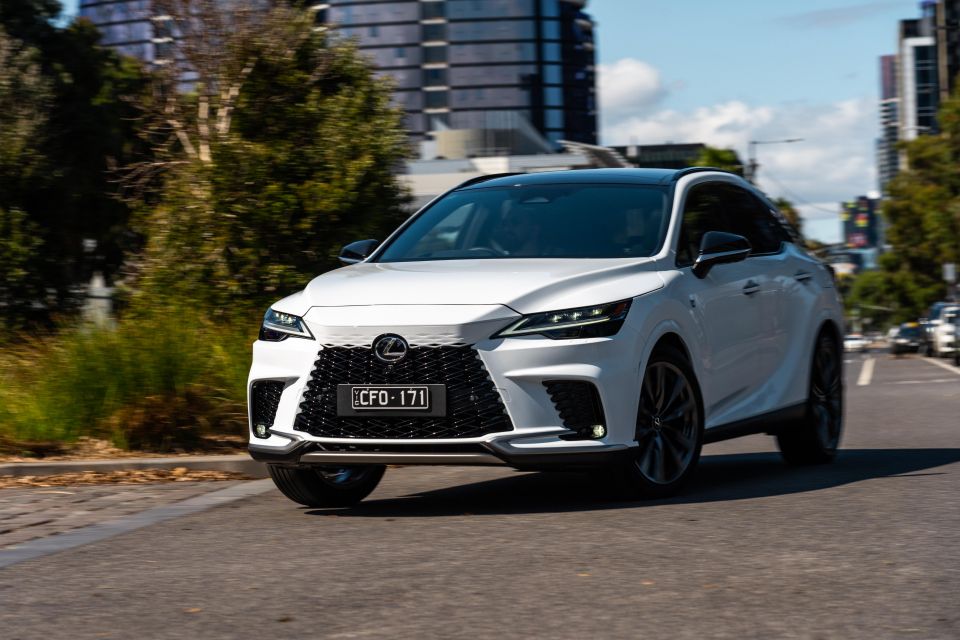
There’s a bit of up and down movement in the ride for what is ostensibly a sporty crossover, so it doesn’t feel quite as tied down as some more athletic rivals.
The trade-off is ride quality that is excellent. The adaptive dampers firm up a bit in Sport mode, but even so configured and driven across unsealed roads, the RX remains extremely comfortable and simply lopes along.
I found myself leaving the RX in Custom mode, allowing me to have firmer suspension without changing the shift mapping. If only it would default to this mode.
I didn’t see the point in setting the transmission to its sportiest setting or using the lovely paddle shifters as the eight-speed is a smooth-shifting unit.
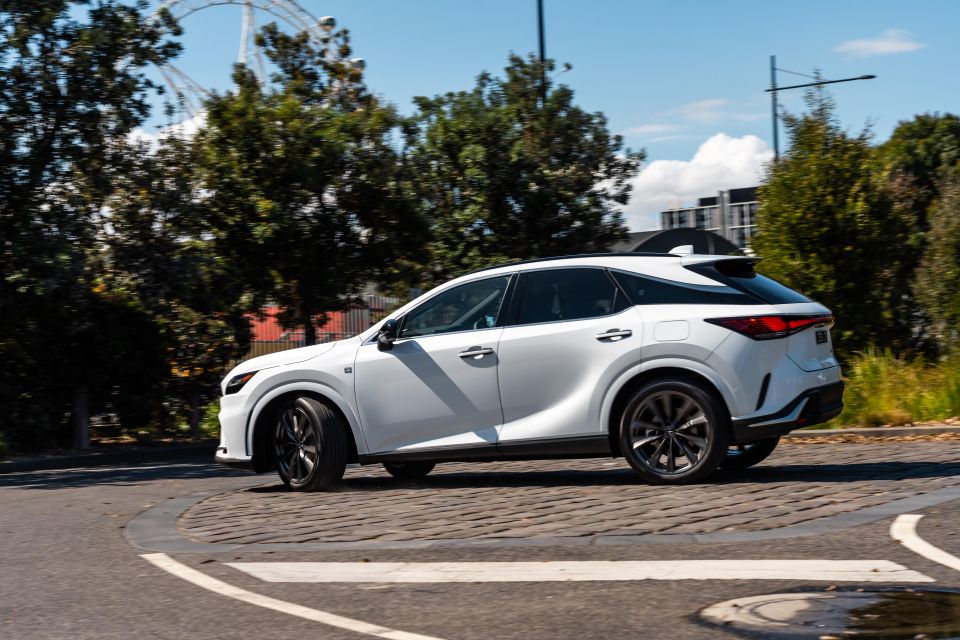
Steering weight and feel doesn’t change noticeably between drive modes, but the tiller is consistently well-weighted if not the most communicative. The lack of feel makes the RX a little less confidence-inspiring in more spirited driving than some rivals, but the well-judged weighting means the RX is easy to pilot during low-speed manoeuvres.
The RX is also capable on a winding road, with well-controlled body roll and a composed feel. It holds on nicely in the corners, staying nice and flat – particularly in Sport mode.
There’s a bit of understeer at the limit, and this isn’t quite as tossable or fun as something like an X3, but it comports itself well.
The GA-K platform underpinning this is also used by other models like the Lexus ES, NX as well as the Toyota Camry, Kluger and RAV4, and as with those models there’s been a tangible improvement in dynamics compared to their old underpinnings.
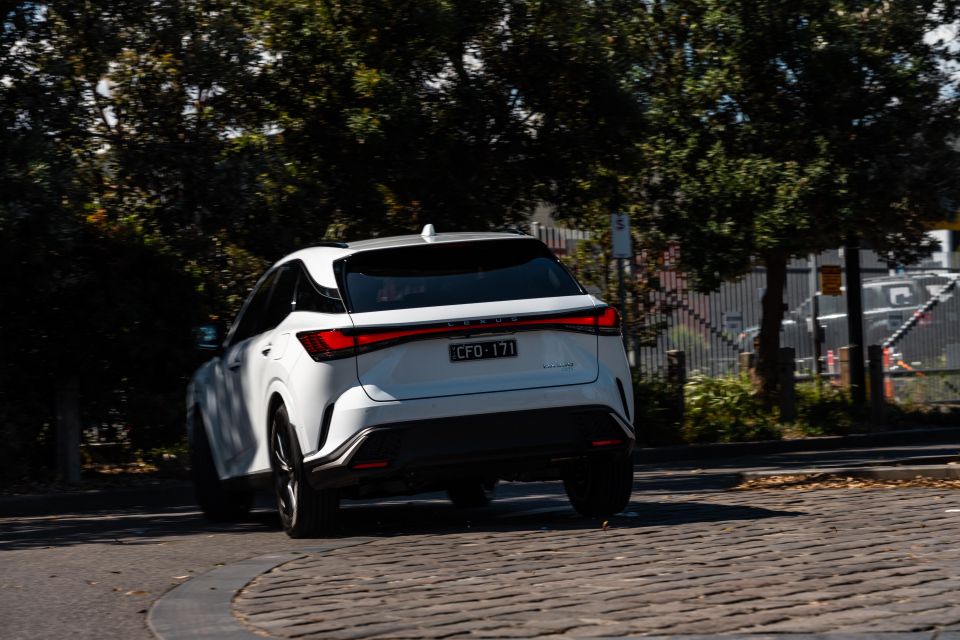
Where expert car reviews meet expert car buying – CarExpert gives you trusted advice, personalised service and real savings on your next new car.
With a 0-100km/h time of just 7.6 seconds, the RX 350 is no rocketship but it’s quick enough. It’s also 0.4 seconds quicker to 100km/h than the old V6-powered RX 350.
It doesn’t pin you back in your seat off the line, but with peak torque available lower in the rev range it feels more flexible than the old V6.
Where the new turbocharged four jars is in its engine note. It has this oddly gravelly sound when you’re heavier with the throttle, and this seems incongruous for a luxury SUV – particularly one with a Lexus badge.
It also stands out because the car is otherwise exceptionally quiet. You waft along in tomb-like silence at highway speeds, with only some faint tyre roar on coarse-chip roads.

Highway driving is particularly pleasant in the RX not just because of the lack of noise, but because the Lane Tracing Assist keeps you centred in your lane without constantly feeling like it’s awkwardly jerking the wheel. Likewise, the lane-keep assist feature is well-calibrated.
The driver attention monitoring can accurately detect if you look away from the road – I had only one false positive, but I was wearing sunglasses at the time. Finally, the adaptive LED headlights are superb.
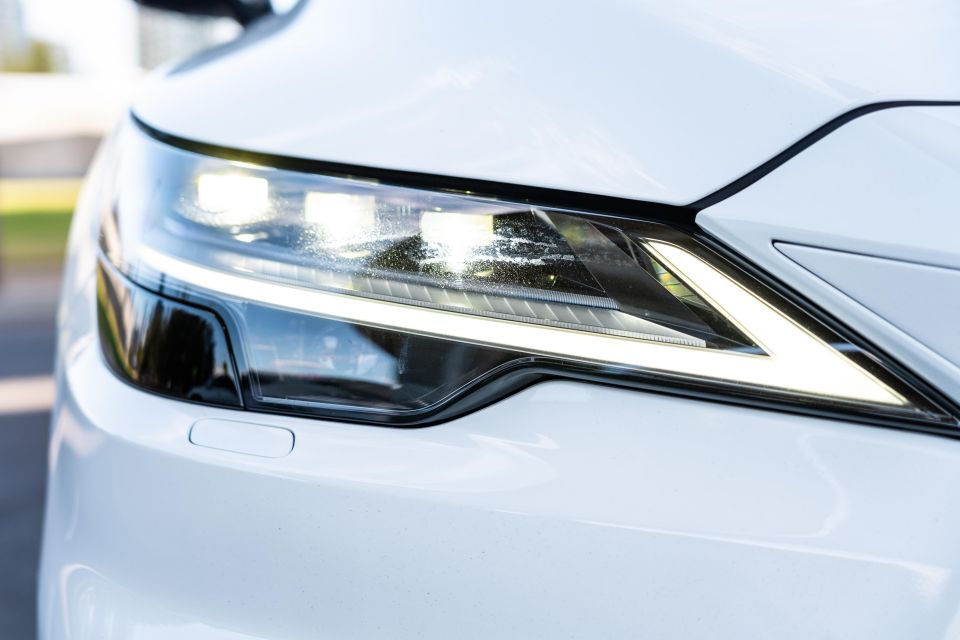

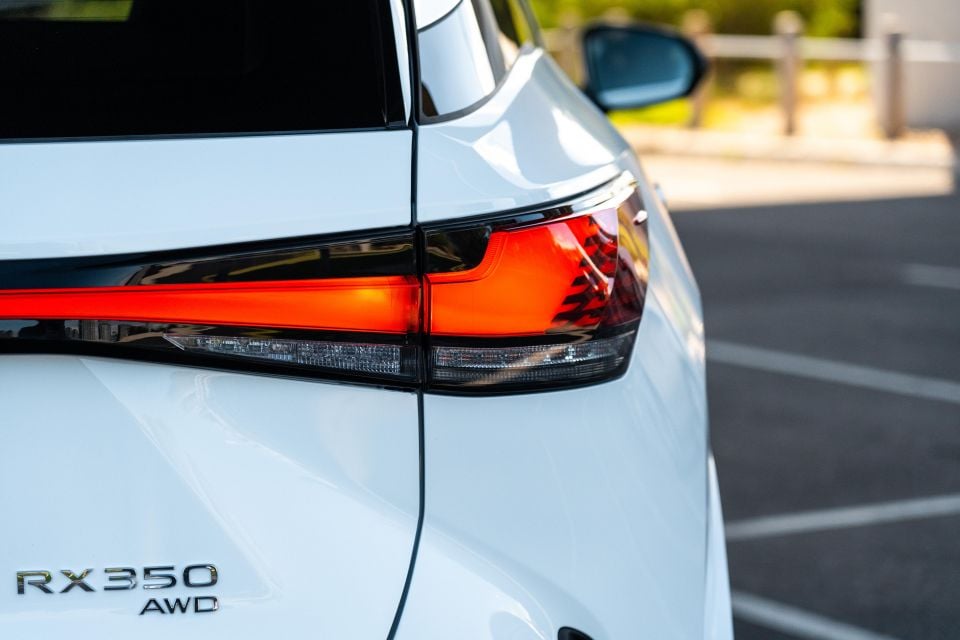

RX 350 F Sport highlights:
The $3000 Enhancement Pack 1 adds a panoramic sunroof, while the $4100 Enhancement Pack 2 includes this plus a digital rear-view mirror, semi-automatic parking assist, and a heated steering wheel.
The Lexus RX has a five-star ANCAP safety rating, based on 2022 Euro NCAP tests.

It received an adult occupant protection rating of 90 per cent, a child occupant protection rating of 89 per cent, a vulnerable road user protection rating of 89 per cent, and a safety assist rating of 93 per cent.
Standard safety equipment includes:
Lexus backs its vehicles with a five-year, unlimited-kilometre warranty.
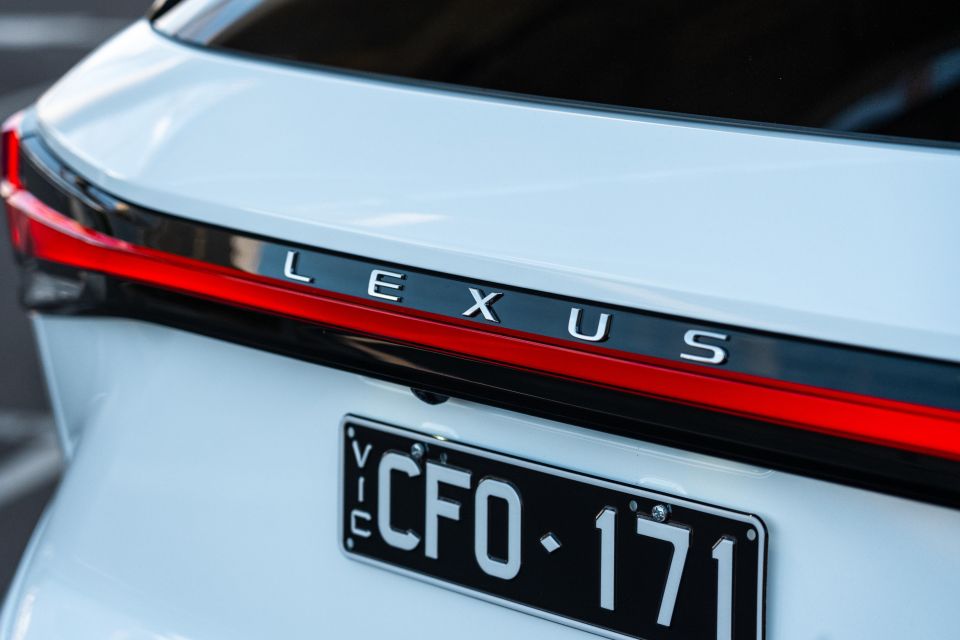
Servicing is required every 12 months or 15,000km, whichever comes first.
The first five services are capped at $695, for a total of $3475 over five years. That’s on the high side, particularly considering Genesis will give you your first five services for free.
Roadside assistance is included as part of the Lexus Encore program, which spans three years. That also allows owners to have their car collected and returned for servicing, as well as offering owners access to a loan car if their vehicle is out of action.
The RX 350 F Sport was never intended to be a cut-price Urus – that’s why it’s an F Sport, and not an F.
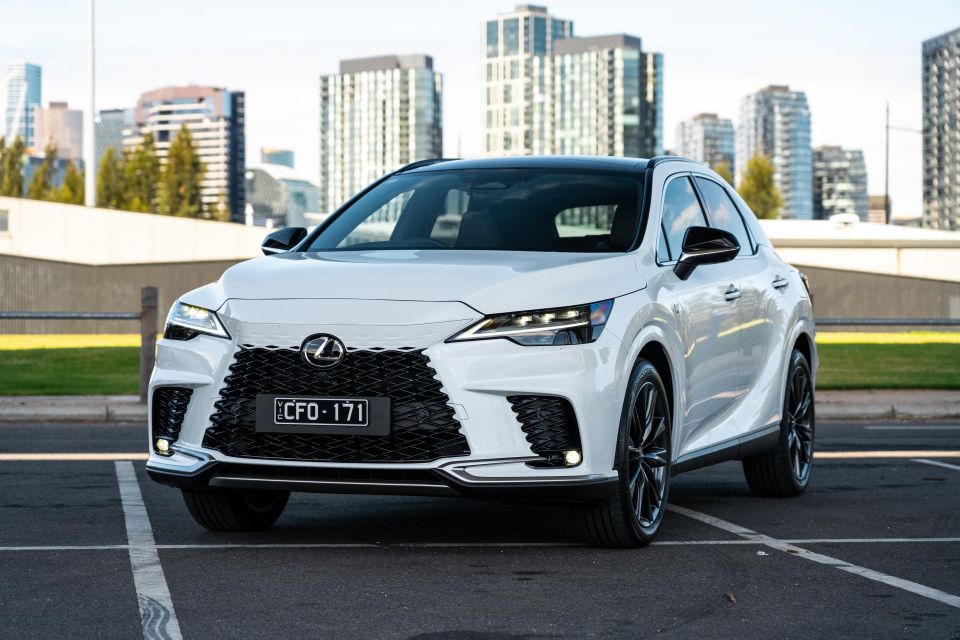
Despite the pseudo-sporty engine note, its performance figures are ho-hum. Its handling is competent, but not athletic enough to win the SUV Olympics.
As with the rest of the RX range, the RX 350 F Sport offers a comfortable ride and a plush, spacious and well-appointed interior, though the panoramic sunroof does eat into headroom a bit.
The Lexus RX has always excelled as a sensible option in this part of the market. It’s never the sportiest option (indeed, it’s often far from it), but it has always offered the level of reliability and quality expected of a Lexus in a comfortable, generally well-packaged crossover.
That’s why the new generation makes more sense as an RX 350h hybrid, where it also boasts better fuel economy and a lower price. One of the most sensible large crossovers on the markets is best bought in its most sensible guise – who’d have thought?
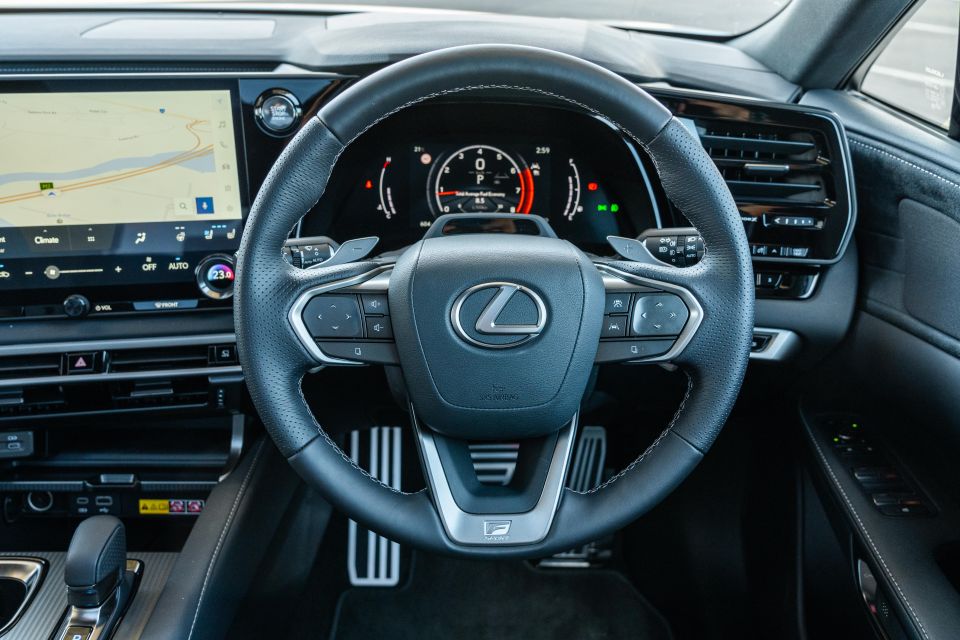
Click the images for the full gallery
BUY: Lexus RX MORE: Everything Lexus RX
Where expert car reviews meet expert car buying – CarExpert gives you trusted advice, personalised service and real savings on your next new car.
William Stopford is an automotive journalist with a passion for mainstream cars, automotive history and overseas auto markets.


Damion Smy
13 Hours Ago


Josh Nevett
4 Days Ago


CarExpert.com.au
5 Days Ago


Damion Smy
6 Days Ago


Derek Fung
7 Days Ago


Ben Zachariah
10 Days Ago